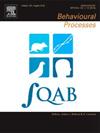Why do Cattle Egrets forage with cattle? An analysis from an anti-predation perspective
IF 1.3
4区 生物学
Q4 BEHAVIORAL SCIENCES
引用次数: 0
Abstract
The risk-benefit trade-off theory is a fundamental concept in the study of animal behavior strategies and remains a prominent topic in animal ecology. Cattle Egrets (Bubulcus ibis) foraging alongside ungulates has garnered considerable attention. Previous research has highlighted the impact of ungulates on disturbing grassland insects, leading to increased foraging success for Cattle Egrets. However, the risk-benefit relationship from an anti-predator perspective remains underexplored. This study, conducted in Yang County, Shaanxi Province, China, focused on Cattle Egrets and compared the foraging efficiency and flight initiation distance (FID) when foraging alongside cattle (Bos spp.) versus foraging alone. Additionally, our study analyzed the impact of increasing cattle numbers on the FID to assess whether foraging with cattle enhances the perceived safety. We hypothesized that, with more cattle, Cattle Egrets would be less vigilant if they can gain vigilance advantages from cattle. The results indicated significantly higher foraging efficiency and lower FID for Cattle Egrets when foraging with cattle compared to foraging alone, suggests that the presence of cattle enables Cattle Egrets to better tolerate potential predation risks. However, more cattle did not significantly affect the FID, indicating that the perceived predation risk of Cattle Egrets did not reduce with more cattle. The lower FID of Cattle Egrets when foraging with cattle is more likely attributed to higher foraging efficiency rather than lower perceived predation risk in their risk-benefit trade-off. This study explores the mechanism of Cattle Egrets foraging with cattle from an anti-predation perspective, enhancing understanding of this phenomenon and contributing to the risk-benefit trade-off hypothesis.
为什么牛白鹭和牛一起觅食?从反捕食角度分析
风险-收益权衡理论是动物行为策略研究中的一个基本概念,也是动物生态学中的一个重要课题。牛白鹭(Bubulcus ibis)与有蹄类动物一起觅食已经引起了相当大的关注。先前的研究强调了有蹄类动物对草地昆虫的影响,从而提高了牛白鹭的觅食成功率。然而,从反捕食者的角度来看,风险-收益关系仍未得到充分探讨。本研究在陕西省阳县以牛白鹭为研究对象,比较了牛白鹭与牛白鹭一起觅食与单独觅食时的觅食效率和飞行起始距离(FID)。此外,我们的研究分析了增加牛的数量对FID的影响,以评估与牛一起觅食是否提高了感知安全性。我们假设,有更多的牛,如果牛白鹭能从牛身上获得警惕优势,它们的警惕性就会降低。结果表明,与单独觅食相比,与牛一起觅食的牛白鹭觅食效率显著提高,FID显著降低,表明牛的存在使牛白鹭能够更好地承受潜在的捕食风险。然而,更多的牛对FID没有显著影响,这表明牛白鹭的感知捕食风险并没有随着牛的增加而降低。与牛一起觅食时,牛白鹭的FID较低更可能是由于觅食效率较高,而不是在风险-收益权衡中感知到的捕食风险较低。本研究从反捕食的角度探讨了牛白鹭与牛一起觅食的机制,增强了对这一现象的理解,并为风险-收益权衡假说提供了依据。
本文章由计算机程序翻译,如有差异,请以英文原文为准。
求助全文
约1分钟内获得全文
求助全文
来源期刊

Behavioural Processes
生物-动物学
CiteScore
2.70
自引率
7.70%
发文量
144
审稿时长
4-8 weeks
期刊介绍:
Behavioural Processes is dedicated to the publication of high-quality original research on animal behaviour from any theoretical perspective. It welcomes contributions that consider animal behaviour from behavioural analytic, cognitive, ethological, ecological and evolutionary points of view. This list is not intended to be exhaustive, and papers that integrate theory and methodology across disciplines are particularly welcome.
 求助内容:
求助内容: 应助结果提醒方式:
应助结果提醒方式:


